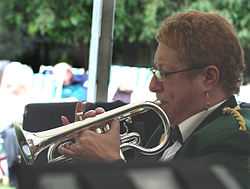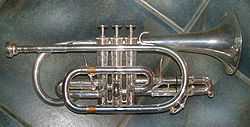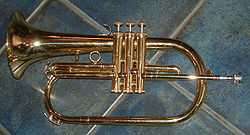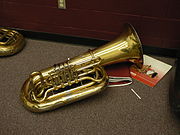Brass band

A brass band is a musical ensemble generally consisting entirely of brass instruments, most often with a percussion section. Ensembles that include brass and woodwind instruments can in certain traditions also be termed brass bands (particularly in the context of New Orleans-style brass bands), but may more correctly termed military bands, concert bands, or 'brass and reed' bands.
Styles
Balkan
Balkan-style Brass Bands (Serbian: Труба, trumpet) play a distinctive style of music originating in 19th-century Balkans when Roma trumpeters influenced by Turkish marching bands transposed Folk music into brass.[1] It is popular throughout the Balkans, especially Serbia, Macedonia and Bulgaria. The beats are usually fast and accompanied by kolo. The performers each have their instrument of the orchestra and are called trubači (трубачи). The best known examples of acclaimed music in this style are from Goran Bregović and Boban Marković Orkestar. The Serbian film maker Emir Kusturica has, through his films (Black Cat, White Cat), made the style popular in the international community outside the Balkans.
British-style
A brass band in the British tradition with a full complement of 28 players[2] (including percussion) consists of:
- 1 Soprano cornet in E♭
- 8-10 Cornets in B♭ (in separate parts for 'Solo', 'Repiano', 2nd and 3rd cornets; there are 4/5 players on the 'Solo' part, one 'Repiano', two 2nd, and two 3rd)
- 1 Flugelhorn in B♭ (notated on the same part as the 'Repiano' in some older music)
- 3 Tenor horns in E♭ (called Solo, 1st and 2nd)
- 2 Baritone horns in B♭ (Each with separate parts)
- 2 Tenor trombones (notated in B♭, playing separate parts)
- 1 Bass trombone (the only brass instrument in the band notated in Concert Pitch (C) on Bass Clef)
- 2 Euphoniums in B♭ (Usually playing the same part with divisi sections)
- 4 Tubas (2 in E♭ and 2 in B♭, both notated in Treble Clef; often called Basses)
- 2 or 3 percussion players (with 2 or more timpani, glockenspiel, snare drum, triangle, cymbals, a drum kit and more)
-

Tenor Horn
-
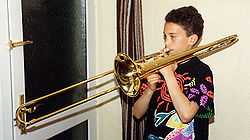
Tenor trombone
-
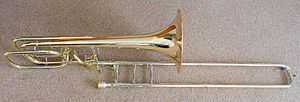
Bass trombone
With the exception of the Trombones and Baritones, all of the brass are conical-bore instruments, which gives the British-style brass band its distinctive bright, mellow sound (as opposed to a dark symphonic sound). All parts apart from the Bass Trombone and percussion are now written in Treble Clef. Note that despite its musical range, the alto horn in E♭ is traditionally called the tenor horn in British bands.
Brass bands have a long tradition of competition between bands, often based around local industry and communities. In the 1930s brass bands thrived most with around 20,000 brass bands in the U.K. British-style brass bands are widespread throughout Great Britain, Australia, New Zealand, Norway and continental Europe and are also found in North America. Annual competitions are held in these countries to select champion bands at various levels of musical competence.
The Salvation Army, part of the Christian church, has deployed brass bands since 1878 and they continue to be an integral part of that organisation. The most well-known Salvation Army brass band is The International Staff Band[3] which is based in London. Salvation Army bands vary considerably in size and complement as they are based on the local personnel available, some being as small as 6-8 members. The cornet section of a Salvation Army band does not include a 'Repiano' and instead of 2nd & 3rd cornets there are 1st & 2nd cornets. A Salvation Army band may have 3-6 tenor horns, 2-4 baritones and 2-6 tenor trombones. Salvation Army bands have a local tradition of training children in brass playing from an early age (starting at 7–8 years old). In larger Salvation Army churches there will often be a Junior Band for children (7–18 years old) as well as a Senior Band for adults.
Low Countries
Fanfare orchestras are a type of brass band mainly found in Belgium and the Netherlands.
New Orleans

The tradition of brass bands in New Orleans, Louisiana dates to the late 19th and early 20th centuries. Traditionally, New Orleans brass bands could feature various instrumentations, often including trumpets, trombones, clarinets, saxophones, sousaphones and percussion. The music played by these groups was often a fusion between European-styled military band music and African folk music brought to the Americas by west African slaves and the idiom played a significant role in the development of traditional jazz. Early brass bands include the Eureka Brass Band, the Onward Brass Band, the Excelsior Brass Band, the Tuxedo Brass Band, the Young Tuxedo Brass Band, the Camelia Brass Band, and the Olympia Brass Band.
The Treme Brass Band, while not as old, has members who have been influential throughout New Orleans Brass Band music, as well as being renowned in its own right.
A well-known use of these bands is for the New Orleans jazz funeral.
In the 1970s and 1980s, the New Orleans brass band tradition experienced a renaissance, with bands breaking away from traditional stylings and adding elements of funk, hip hop, and bop to their repertoires. Some notable exponents of this style of brass band include the band Def Generation, members of the next generation of Nevilles who created hip hop over live brass bands influencing, Soul Rebels Brass Band, Rebirth Brass Band, the Stooges Brass Band, the Hot 8 Brass Band, the Lil Rascals Brass Band, Youngblood Brass Band and the Dirty Dozen Brass Band. Also, a number of groups outside the United States have begun playing this style of music.
The style of the music is often characterized by the use of the sousaphone in place of a bass violin to play the bass-line. The sousaphone may play a traditional jazz walking bass-line or groove on a riff. Trumpets, trombones, saxophones, and other horns play melodies and harmonies loosely over the bass-line. Often the lines are greatly embellished with improvisation. A typical setup includes two percussionists, one playing a marching bass drum and a cymbal mounted on the drum and another playing a snare drum (the snare drummer often switches to a drum kit when not marching). Many variations on this exist, including the use of additional percussionists, cymbals, drums and whistles.
The style has moved beyond New Orleans and can now be found in such places as Japan with the Black Bottom Brass Band; the Netherlands with the Happy Feet and the Hurricane brass bands; Scotland with the Criterion Brass Band; Australia with the Horns of Leroy Brass Band; Phoenix, Arizona with the Bad Cactus Brass Band; Boston, Massachusetts with the Hot Tamale Brass Band; Tennessee with Halfbrass; Minnesota with the Jack Brass Band and the Dirty Shorts Brass Band; Missouri with the Funky Butt Brass Band; Georgia with the Half Dozen Brass Band; Cincinnati, Ohio with The Cincy Brass; and Madison, Wisconsin with the Mama Digdown's and Youngblood;Richmond,VA No BS! Brass brass bands.
Polynesia
Founded in 1836 by King Kamehameha III, the Royal Hawaiian Band is the second oldest and only full-time municipal band in the United States. In recent generations, unique brass band traditions have also developed in Tonga, Samoa, and other parts of Polynesia, as well as among the Māori of New Zealand. Some recordings are now available and these styles are beginning to be researched and promoted abroad through band tours.
Festivals and Contests
One festival featuring brass bands is the Tarragona international dixieland festival, in Catalonia, Spain. The organisation programs not only dixieland brass bands but also ethnic or world music brass bands from over the world, including the Dirty Dozen Brass Band from the USA, Boban Marković Orkestar from Serbia, the Jaipur Kawa Brass Band from India and Taraf Goulamas from Occitania France.
In the United States the Great American Brass Band Festival has been held annually in Danville, Kentucky for the past 18 years. This event, held in early June, attracts brass band lovers from the U.S., Canada, and Europe. The Vintage Band Festival occurs in Northfield, Minnesota every three years,[4] with the next one scheduled for August 1-4 2013.
The North American Brass Band Association[5] sponsors an annual convention that provides member bands with the opportunity to compete in a contest format similar to those conducted in the United Kingdom and Europe.
In Boston, and Seattle a series of festivals called HONK! bring together Street Brass Bands (and other related ensembles) from the United States and Canada, and some bands from other parts of the world. The groups presented include Balkan Brass Bands, New Orleans brass bands, Political Action Bands, Klezmer, and "DIY" Alternative / Radical Community Bands.
Lists
Brass bands
- Alpine energy Timaru brass
- Banda Music
- Bestwood Welfare Black Diamonds Brass Band
- Black Dyke Mills Band
- Boston Brass Band
- Boston Brigade Band
- Brass Band Buizingen
- Brass Instruments
- Brass quintet
- Brighouse and Rastrick Brass Band
- Buraban
- Cambridge University Brass Band (CUBB)[6]
- Central Park Brass
- Chalk Farm Band of the Salvation Army
- City of Oxford Silver Band
- Desford Colliery Brass Band[7]
- Dublin Silver Band[8]
- Eastern Iowa Brass Band
- Flowers Brass Band[9]
- Foden's Band[10]
- Footscray-Yarraville City Band[11]
- Grimethorpe Colliery Band[12]
- Hackney Colliery Band [13]
- Helston Town Band[14]
- Herb Alpert & the Tijuana Brass
- HONK!
- Hosen Brass Band [15]
- Hungry March Band
- Hypnotic Brass Ensemble [16]
- International Staff Band of the Salvation Army
- Landrake Band[17]
- Lanner and District Silver Band
- Leyland Band
- London Metropolitan Brass[18]
- Maidenhead Citadel Band of the Salvation Army
- Mama Brass and the Funk Parade
- Marching band
- Mow The Brass [19]
- Music of Polynesia
- Music of Samoa
- Music of Tonga
- Māori music
- North York Temple Band of The Salvation Army[20]
- Onchan Silver Band
- Reg Vardy Band
- Riot Jazz Brass Band [21]
- River City Brass Band
- Rode Hall Silver Band
- Soul Rebels Brass Band
- South Brisbane Federal Band (The Feds)
- Tapton Youth Brass Band
- Tarragona international dixieland festival in Catalonia, Spain.
- The Band Of The Royal Regiment Of New Zealand Artillery[22]
- The City of Wolverhampton Brass Band
- The Harrogate Band
- The Original Pinettes Brass Band
- Triangle Brass Band
- Vena Mills Band[23]
- Vernon Building Society (Poynton) Brass Band
- Youngblood Brass Band
- Yorkshire Imperial Band
Brass band composers
- Adrian Drover
- Alan Fernie
- Alex Lithgow
- Arthur Butterworth
- Bram Tovey
- Brian Bowen
- Bruce Fraser
- Christopher Bond
- Darrol Barry
- Dean Goffin
- Dean Jones
- Derek Bourgeois
- Derek Broadbent
- Dwanye Bloomfield
- Edward Gregson
- Eric Ball
- Erik Leidzen
- George Allen
- Goff Richards
- Gordon Langford
- Frederik Magle
- Henry James Metcalfe
- Herb Alpert
- James McFadyen
- John McCabe
- Jonathan Bates
- Kenneth Downie
- Leslie Condon
- Lucy Pankhurst
- Marcus Venables
- Martin Cordner
- Martin Ellerby
- Meredith Willson
- Nat McIntosh
- Nigel Clarke
- Norman Bearcroft
- Ørjan Matre
- Paul Lovatt-Cooper
- Peter Graham
- Peter Meechan
- Philip Harper
- Philip Sparke
- Philip Wilby
- Ray Steadman-Allen
- Robert Redhead
- Rodney Newton
- Simon Dobson
- Ted Huggens
- Tom Davoren
- Torstein Aagaard-Nilsen
- William Himes
- William Rimmer
- William F Saunders
Brass band publishers
- Adios Music
- Art of Sound Music
- Band Press VOF
- Bravo Music
- De Haske
- Devilish Publishing
- Elms Publishing
- Faber Music
- Francis Clifford Publishing
- Gramercy Music
- JAGRINS
- Kantaramusik
- Kirklees Music
- Maverick Music
- PLC Music
- Prima Vista Musikk
- Salvationist Publishing and Supplies
- SJS Music
- Studio Music
- Wright & Round
Brass band instrument manufacturers, historical and present
- Antoine Courtois[24]
- Besson[24]
- Blessing[25]
- Boosey and Hawkes[24]
- Boston Musical Instrument Company[24]
- C.G. Conn, Ltd. (later Conn-Selmer)[24]
- E.A. Couturier[24]
- E.G. Wright and Company[26]
- F.A. Reynolds[24]
- F.E. Olds[24]
- Graves and Sons[26]
- Hall and Quinby[27]
- Hirsbrunner[28]
- J. W. York[24]
- Jupiter Band Instruments[24]
- The Standard Band Instrument Company[24]
- Smith Watkins[29]
- The Frank Holton Company[24]
- The H.N. White Company (King Musical Instruments)[24]
- The Martin Band Instrument Company[24]
- Vincent Bach Corporation[24]
- Willson[30]
- Yamaha Musical Instruments[24]
References
- ↑ "Bradt Travel Guide Serbia - Laurence Mitchell - Google Böcker". Books.google.se. Retrieved 2014-06-04.
- ↑ "Writing For Brass Bands". Bandsman.co.uk. Retrieved 2014-06-04.
- ↑ http://www.theisb.com/
- ↑ http://vintagebandfestival.org/
- ↑ http://www.nabba.org/
- ↑ http://cubb.soc.srcf.net/
- ↑ http://www.desfordcollieryband.co.uk
- ↑ http://dublinbands.com/bands/silver-band/
- ↑ http://www.flowersband.co.uk
- ↑ http://www.fodensband.co.uk
- ↑ http://fycb.com.au/
- ↑ http://www.grimethorpeband.com
- ↑ http://www.hackneycollieryband.co.uk
- ↑ http://www.helstontownband.co.uk
- ↑ http://www.hosenbrass.com
- ↑ http://www.hypnoticbrassensemble.com
- ↑ http://www.landrakeband.co.uk/
- ↑ http://www.londonmetropolitanbrass.com
- ↑ http://www.mowthebrass.co.uk/
- ↑ http://nytband.com/
- ↑ http://riotjazz.com
- ↑ http://www.nzartilleryband.co.nz/
- ↑ http://www.reverbnation.com/venamillsband
- ↑ 24.0 24.1 24.2 24.3 24.4 24.5 24.6 24.7 24.8 24.9 24.10 24.11 24.12 24.13 24.14 24.15 Please refer to linked article on the manufacturer and sources cited therein
- ↑ "Blessing Brass Instruments website". Retrieved 2011-07-18.
- ↑ 26.0 26.1 Wikipedia Article Boston Musical Instrument Company
- ↑ Wikipedia Article Vega Company
- ↑ "Hirsbrunner website". Retrieved 2011-07-18.
- ↑ "Smith Watkins website". Retrieved 2011-07-18.
- ↑ "Willson website". Retrieved 2011-07-18.
External links
- Brass Bands- Services for contacting bands and players worldwide
- 4barsrest- Up to date news and articles on the brass band scene
- IBEW- The complete information resource for brass bands worldwide
- British Bandsman magazine
- Brass Band Tube - All the latest Brass Band videos on the internet
- BrassBand.co.uk-Brass Band Sheet Music Search Engine
- Matt Sakakeeny-Tulane University musicologist has written extensively on New Orleans brass bands
- The Stooges Brass Band - A contemporary New Orleans-style brass band.
- The Australian Newcastle Steelworks Band's London recordings, including the 'Honest Toil March' was added to the National Film and Sound Archive's Sounds of Australia Registry in 2009
- The Newcastle Steelworks Band playing W. Rimmer’s 'Honest Toil March' on australianscreen online
- Stonehouse (Gloucestershire) Brass Band 1898
- Champion Brass- The Whit Friday Brass Band Experience
